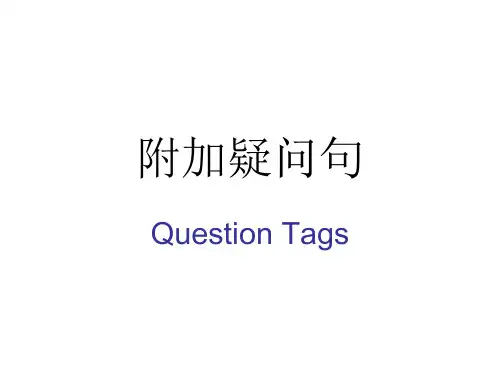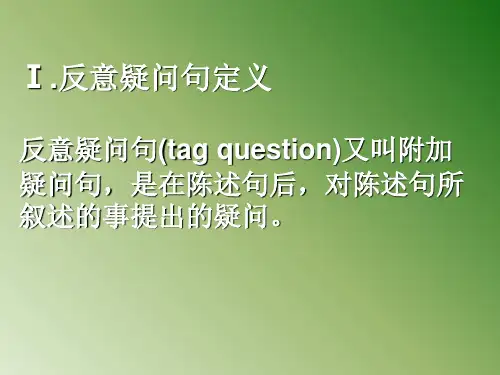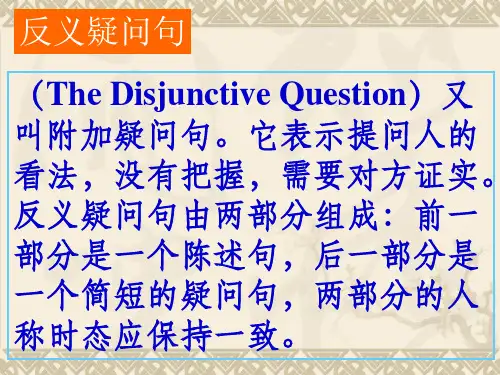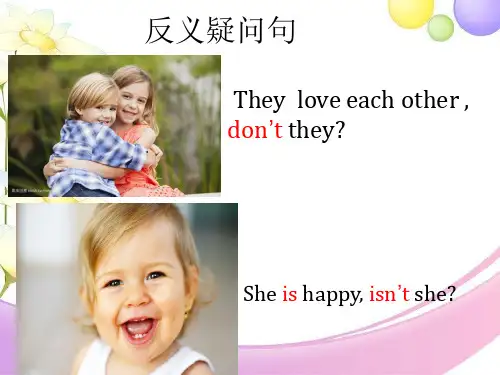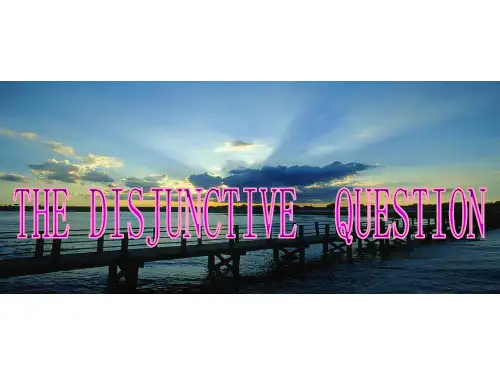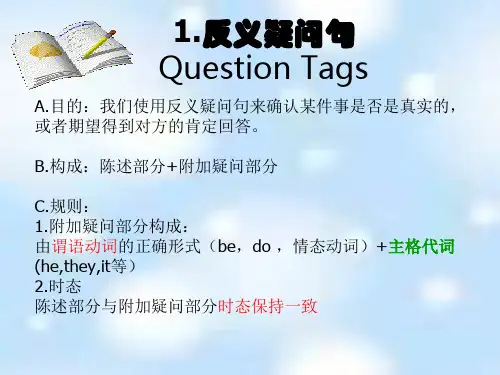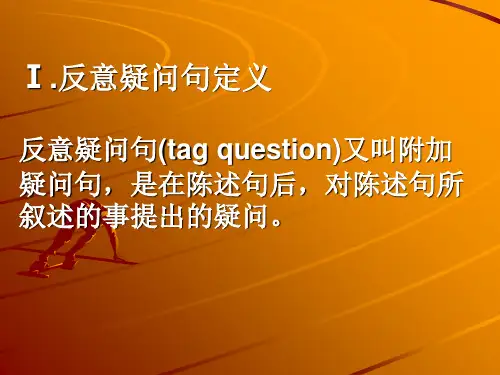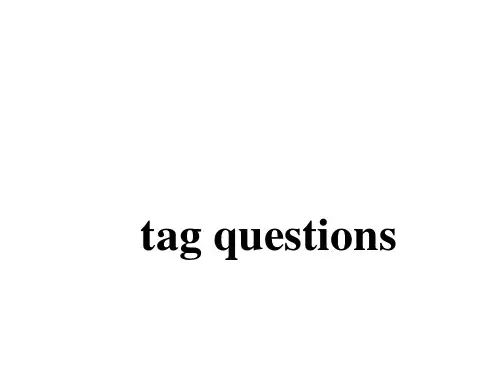- 1、下载文档前请自行甄别文档内容的完整性,平台不提供额外的编辑、内容补充、找答案等附加服务。
- 2、"仅部分预览"的文档,不可在线预览部分如存在完整性等问题,可反馈申请退款(可完整预览的文档不适用该条件!)。
- 3、如文档侵犯您的权益,请联系客服反馈,我们会尽快为您处理(人工客服工作时间:9:00-18:30)。
I don’t believe he has finished his work.
7.当陈述部分的主句是I think (expect, believe)等结构时,反 意疑问句的附加部分则往往与从 句中的主语和谓语动词保持对应 关系,但要注意否定的转移。 例如:
I think he’s funny, isn’t he? I don’t believe she likes my
You must have seen the film last week, didn’t you?
6. 当陈述部分是I am…时,反意疑 问句部分通常要用aren’t I;如陈述 句部分的主语是I am not时,反意疑 问句部分通常要用am I。 例如:
1)I am a teacher, aren’t I?
Ⅰ.反意疑问句定义
反意疑问句(tag question)又叫附加 疑问句,是在陈述句后,对陈述句所 叙述的事提出的疑问。
Ⅱ.基本结构:
陈述句+逗号+简短的一般疑问句?
遵循前肯定后否定前否后肯式的原则
①前肯后否式。例如:
You are all students, aren’t you﹖
②前否后肯式。例如:
Let’s have a rest, shall we? 以let us开头的祈使句,不包括 说话人在内,因此反意疑问句的 附加部分用will you。例如:
Let us stop now, will you?
Ⅳ. 反意疑问句的回答 “ 根据事实回答”
对反意疑问句的回答,无论问题的提法如何,如果 事实是肯定的,就用yes,事实是否定的,就要用no。 要特别注意陈述句部分是否定结构,反意疑问句部分 用肯定式提问时,回答yes或no与汉语正好相反。这 种省略回答的yes要译成“不”,no要译成“是”。
---Yes, she did. / No, she didn’t. 不,她参加了。/
是的,她没参加。
Fill in the blanks:
①The boy is Japanese, _i_s_n_'t__he? ②The book isn't interesting, __i_s___ it? ③He knows a lot about English names, d_o__e_s_n_'t he? ④The girl doesn't like apples, __d_o_e_s_ she? ⑤There are two birds in the tree, _a_r_e_n_'t_ there? ⑥The man came to China last month, _d_i_d_n_'t_ he?
The End
8.在由“祈使句+反意疑问句”构成 的反意疑问句中,附加疑问部分一 般用will you, 例如: 1)Don’t close the window, will
you? 2)Be quiet, will you?
注: 在以let’s开头的祈使句之后, 因为包括说话人本人,反意疑问 部分用shall we。 例如:
②前后两部分时态必须一致。例 如:
[误] She read an interesting book yesterday, doesn’t she﹖
[正] She read an insteresting book yesterday, didn’t she﹖
③前后两部分的主语(即人称 单、复数)必须一致,而且后一 部分的主语常用代词代替。例如:
3.但若陈述部分的主语是
everything, anything, something, nothing等指物的不 定代词时,反意疑问句的附加部 分的主语只能用it。 例如:
Nothing could stop them, could it?
Everything is ready, isn’t it?
they? 现在进行时:
You’re going to the cinema,
_a_r_e_n_’t__ you? She isn’t waiting for me, ___is____
she?
一般过去时:
They had a good time at the party last Saturday, _d_i_d_n_’t_ they? Fanny didn’t go home last night, __d_i_d__ she? 一般将来时:
7当陈述部分含有need时,如果need用作行为 动词,则附加问句的动词应用do;如果need用 作情态动词,则附加问句的动词应用need。
We need to arrive in Shanghai at 7:00,don’t we?
8 当陈述部分含有情态动词must 时,有以下几 种情况:
1)must表示“必须”之意,附加问句的 谓语用needn’t。
例 1)---He likes playing football, doesn’t he? 他喜 欢踢足球,是吗
---Yes, he does. / No, he doesn’t. 是的。/ 不是。
2)---His sister didn’t attend the meeting, did she? 他妹妹没有参加会议,是吗?
完成下列反意疑问句
(1)You’re a farmer, __a_r_e_n_’_t ___y_o_u___? (2)The weather isn’t fine, __i_s___ __it___? (3)Kate came here last month, _d_id__n_’t __s_h_e__? (4)I don’t think Tom is at home, ___is__ _h_e___? (5)There weren’t enough nuts, _w_e_r_e_ _th_e_r_e_? (6)There’s a pen in the pencil-box, _is_n_’_t _th__e_re_? (7)The man had bread for lunch, _d_i_d_n_’t_ _h_e__? (8)Mary can speak little English , __c_a_n_ __s_h_e__? (9)Nothing is wrong with the watch, __i_s_ __it___?
He has lived here since 1949, hasn’t he?
Ⅲ.反意疑问句特例
1.当陈述句的主语是指示代词this, that时,反意 疑问句的主语用it代替;指示代词是these, those 时,反意疑问句的主用they代替。
1) That isn’t a useful book, is it? 2)These are important reading materials,
clothes, does she?
注 : 如果主句的主语是第二,三 人称时,否定词一般不转移,它 的反义疑问句的主谓应与主句一 致。
1)Mary thinks you will come to
the party, doesn’t she? 2)He thinks he can’t go with you, doesn’t he ?
Few people know him, do they? She never goes swimming, does she?
6 当陈述部分动词为have(has)时,有以下几种 情况:
1)Have在一般现在时中表示“有”之意,附加 问句的谓语可用have也可用助动词do.
Eg Tom has a new watch ,hasn’t /doesn’t he?
aren’t they?
2.当陈述部分的主语是everybody, everyone, someone, no one, nobody, somebody等指人的不定代词时,反意 疑问句的附加部分的主语通常用they,但 也可用he。例如:
1)Everybody is here, isn’t he? 2)Nobody wants to go there, don’t they?
2)I’m late for the meeting, aren’t I?
否定转移:当主句的谓语动词是 think,believe,guess,expect,suppose等, 而且主句的主语又是第一人称时,后接的 宾语从句的否定词通常要前移到主句中, 即否定转移。
Eg I don’t think he will come with you.
4.当陈述部分是there be句型时, 反意疑问句的附加部分的主语也 用there。 例如:
1)There’s not any hபைடு நூலகம்lp for it, is there? 2)There’re some apples on the table, aren’t there?
5.陈述部分带有 never, few, little, hardly,seldom,nobody,none,no, too…to, nothing等否定意义的词时, 反意疑问句的附加部分的动词用肯 定形式。 例如:
2) have to表示“不得不,必须”之意 时,附加问句的谓语应用助动词do.
Kate has to help her mother at home,doesn’t she?
3) have表示“吃,喝,玩,度过”等意 思时,其附加问句的谓语应用助动词do.
They had a good time in Beijing ,didn’t they?
They must come on time,needn’t they?
2)must表示推测,“一定,想必”之意,附加问 句的谓语动词的确定应根据must后面的动词。
